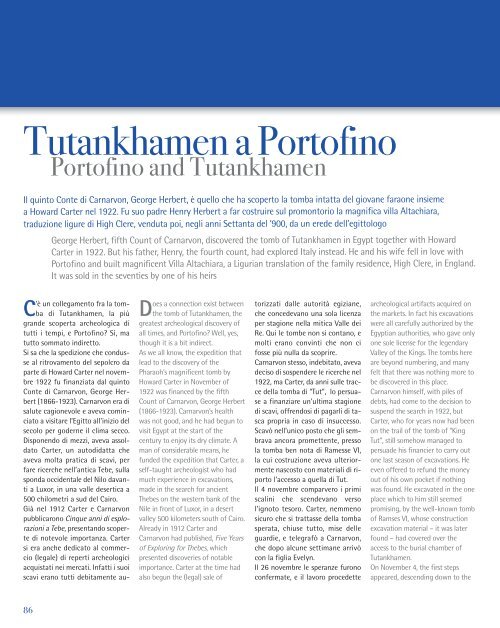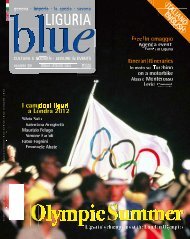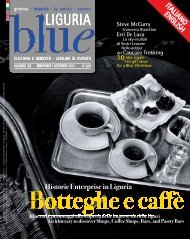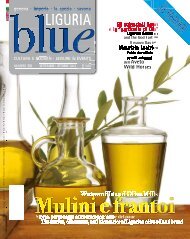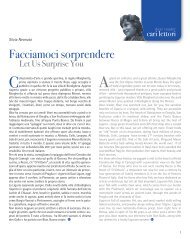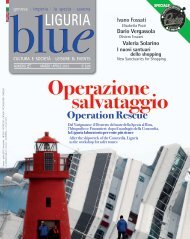You also want an ePaper? Increase the reach of your titles
YUMPU automatically turns print PDFs into web optimized ePapers that Google loves.
lue<br />
taste<br />
Tutankhamen a Portofino<br />
Portofino and Tutankhamen<br />
Il quinto Conte di Carnarvon, George Herbert, è quello che ha scoperto la tomba intatta del giovane faraone insieme<br />
a Howard Carter nel 1922. Fu suo padre Henry Herbert a far costruire sul promontorio la magnifica villa Altachiara,<br />
traduzione ligure di High Clere, venduta poi, negli anni Settanta del ‘900, da un erede dell’egittologo<br />
George Herbert, fifth Count of Carnarvon, dis<strong>cover</strong>ed the tomb of Tutankhamen in Egypt together with Howard<br />
Carter in 1922. But his father, Henry, the fourth count, had explored Italy instead. He and his wife fell in love with<br />
Portofino and built magnificent Villa Altachiara, a <strong>Liguria</strong>n translation of the family residence, High Clere, in England.<br />
It was sold in the seventies by one of his heirs<br />
C<br />
’è un collegamento fra la tomba<br />
di Tutankhamen, la più<br />
grande scoperta archeologica di<br />
tutti i tempi, e Portofino? Sì, ma<br />
tutto sommato indiretto.<br />
Si sa che la spedizione che condusse<br />
al ritrovamento del sepolcro da<br />
parte di Howard Carter nel novembre<br />
1922 fu finanziata dal quinto<br />
Conte di Carnarvon, George Herbert<br />
(1866-1923). Carnarvon era di<br />
salute cagionevole e aveva cominciato<br />
a visitare l’Egitto all’inizio del<br />
secolo per goderne il clima secco.<br />
Disponendo di mezzi, aveva assoldato<br />
Carter, un autodidatta che<br />
aveva molta pratica di scavi, per<br />
fare ricerche nell’antica Tebe, sulla<br />
sponda occidentale del Nilo davanti<br />
a Luxor, in una valle desertica a<br />
500 chilometri a sud del Cairo.<br />
Già nel 1912 Carter e Carnarvon<br />
pubblicarono Cinque anni di esplorazioni<br />
a Tebe, presentando scoperte<br />
di notevole importanza. Carter<br />
si era anche dedicato al commercio<br />
(legale) di reperti archeologici<br />
acquistati nei mercati. Infatti i suoi<br />
scavi erano tutti debitamente au-<br />
86<br />
Does a connection exist between<br />
the tomb of Tutankhamen, the<br />
greatest archeological dis<strong>cover</strong>y of<br />
all times, and Portofino? Well, yes,<br />
though it is a bit indirect.<br />
As we all know, the expedition that<br />
lead to the dis<strong>cover</strong>y of the<br />
Pharaoh’s magnificent tomb by<br />
Howard Carter in November of<br />
1922 was financed by the fifth<br />
Count of Carnarvon, George Herbert<br />
(1866-1923). Carnarvon’s health<br />
was not good, and he had begun to<br />
visit Egypt at the start of the<br />
century to enjoy its dry climate. A<br />
man of considerable means, he<br />
funded the expedition that Carter, a<br />
self-taught archeologist who had<br />
much experience in excavations,<br />
made in the search for ancient<br />
Thebes on the western bank of the<br />
Nile in front of Luxor, in a desert<br />
valley 500 kilometers south of Cairo.<br />
Already in 1912 Carter and<br />
Carnarvon had published, Five Years<br />
of Exploring for Thebes, which<br />
presented dis<strong>cover</strong>ies of notable<br />
importance. Carter at the time had<br />
also begun the (legal) sale of<br />
torizzati dalle autorità egiziane,<br />
che concedevano una sola licenza<br />
per stagione nella mitica Valle dei<br />
Re. Qui le tombe non si contano, e<br />
molti erano convinti che non ci<br />
fosse più nulla da scoprire.<br />
Carnarvon stesso, indebitato, aveva<br />
deciso di sospendere le ricerche nel<br />
1922, ma Carter, da anni sulle tracce<br />
della tomba di “Tut”, lo persuase<br />
a finanziare un’ultima stagione<br />
di scavi, offrendosi di pagarli di tasca<br />
propria in caso di insuccesso.<br />
Scavò nell’unico posto che gli sembrava<br />
ancora promettente, presso<br />
la tomba ben nota di Ramesse VI,<br />
la cui costruzione aveva ulteriormente<br />
nascosto con materiali di riporto<br />
l’accesso a quella di Tut.<br />
Il 4 novembre comparvero i primi<br />
scalini che scendevano verso<br />
l’ignoto tesoro. Carter, nemmeno<br />
sicuro che si trattasse della tomba<br />
sperata, chiuse tutto, mise delle<br />
guardie, e telegrafò a Carnarvon,<br />
che dopo alcune settimane arrivò<br />
con la figlia Evelyn.<br />
Il 26 novembre le speranze furono<br />
confermate, e il lavoro procedette<br />
archeological artifacts acquired on<br />
the markets. In fact his excavations<br />
were all carefully authorized by the<br />
Egyptian authorities, who gave only<br />
one sole license for the legendary<br />
Valley of the Kings. The tombs here<br />
are beyond numbering, and many<br />
felt that there was nothing more to<br />
be dis<strong>cover</strong>ed in this place.<br />
Carnarvon himself, with piles of<br />
debts, had come to the decision to<br />
suspend the search in 1922, but<br />
Carter, who for years now had been<br />
on the trail of the tomb of “King<br />
Tut”, still somehow managed to<br />
persuade his financier to carry out<br />
one last season of excavations. He<br />
even offered to refund the money<br />
out of his own pocket if nothing<br />
was found. He excavated in the one<br />
place which to him still seemed<br />
promising, by the well-known tomb<br />
of Ramses VI, whose construction<br />
excavation material – it was later<br />
found – had <strong>cover</strong>ed over the<br />
access to the burial chamber of<br />
Tutankhamen.<br />
On November 4, the first steps<br />
appeared, descending down to the


